Small garden ideas – 21 ways to elevate a tiny outdoor space
From plants to layouts and visual tricks, these small garden ideas from the experts will help you make the most of even the most miniature backyard

Hugh Metcalf

The best small garden ideas ensure that when it comes to your outdoor space, square footage isn't everything. These design tricks can make your garden look bigger, can ensure you have all the features you want in even the most compact space, and also help your garden plants thrive.
The key to picking the right garden ideas when you don't have much space to play with? Be selective. Set yourself a brief for your outdoor area that really focuses on how you want to use the space. Whether you want to create an extension to your living space to use over summer or fill your garden with beautiful plants for a great view out from your home, get your priorities in order and focus your attention.
From this variety of small garden ideas we've curated for this gallery, you'll find that in the right space, almost nothing is off the table, just because you've got a compact garden. From outdoor living rooms and kitchens to summerhouses and pools, take inspiration from these real outdoor spaces that have been designed to make the most of them possible.
Small garden ideas that are big on style
Dividing up a patio or terrace into different heights, for example with decking, will actually make the space feel larger and zone different areas. Creating built-in planters or tiered levels will also double up as seating, eliminating the need for bulky furniture. Just add some pretty banquette style cushions et voila.
Or, for something more flexible than borders, go for potted plants which can easily be moved around and interchanged. Not much space for plants? Think vertically. If budget is no issue, invest in creating a striking living wall, or for rental spaces or something more budget-friendly, arrange potted herbs and plants on high shelves instead, freeing up floor space. See, already plenty of small garden ideas to get you started...
1. Consider how you want to use the space

When designing a small garden, as with small rooms deciding on exactly what you want in the space, and how it will be used is a good place to start.
'Think long and hard about how you want to use your garden.' suggests garden designer Dan Cooper. If you love to entertain, that will lead you in one direction, if you want to try your hand at growing your own veg, that will lead in another. The chances are you'll want to create a multi-functional space, and that requires careful planning. Make sure you understand where the sun falls at different times of day, where the wind blows, places where you might be overlooked by neighbors and where you have the best soil to grow in.
The Livingetc newsletters are your inside source for what’s shaping interiors now - and what’s next. Discover trend forecasts, smart style ideas, and curated shopping inspiration that brings design to life. Subscribe today and stay ahead of the curve.
'Make a list of priorities and address the most critical one first. You may have to make a few compromises down the line, but outdoor spaces can be surprisingly flexible. Attracting wildlife might simply be a case of choosing the right plants, rather than designing the space differently. Gardens will evolve as your circumstances and preferences change - they don't have to do everything at once.'
2. Create a space for socializing

If you're not the green-fingered type, a garden doesn't have to be designed for gardening. This backyard design in San Francisco by Steve Ritchey of Seed Studio Landscape Design had a brief that focused more on time spent socializing outdoors than looking after plants.
'The clients had two directives, they wanted to frequently host gatherings with friends and yet to keep a relaxing, spa-like vibe for just the two of them to unwind,' explains Steve. And despite the compact size in comparison to many backyards, the designer managed to pack a lot of features into this outdoor living room.
'Ways to keep warm in our cold and foggy San Francisco weather were important to them so we have a cedar hot tub, sauna, firepit, and heated concrete lounges on the upper deck,' he says. 'I really enjoy the challenge of maintaining a clean and integrated aesthetic while packing a lot of functionality into a garden.'
3. Expand the sense of space by blurring the boundaries

'There are lots of cunning ways to make a small garden feel bigger. The easiest way is to 'borrow' landscape beyond your boundary to give the illusion that your space extends further: don't box yourself in if there's something attractive in the distance to draw your eye,' suggests Dan.
'Consider how you can lay your garden out to create a sense of mystery. Hide fences with climbers and evergreen plants, and allow paths to meander behind a hedge or trellis to create a sense that something lies beyond. If you have a narrow plot, laying out paving, beds, and lawns on the diagonal will cheat your eye into thinking the garden is wider than it is.'
4. Go wall to wall with a swimming pool
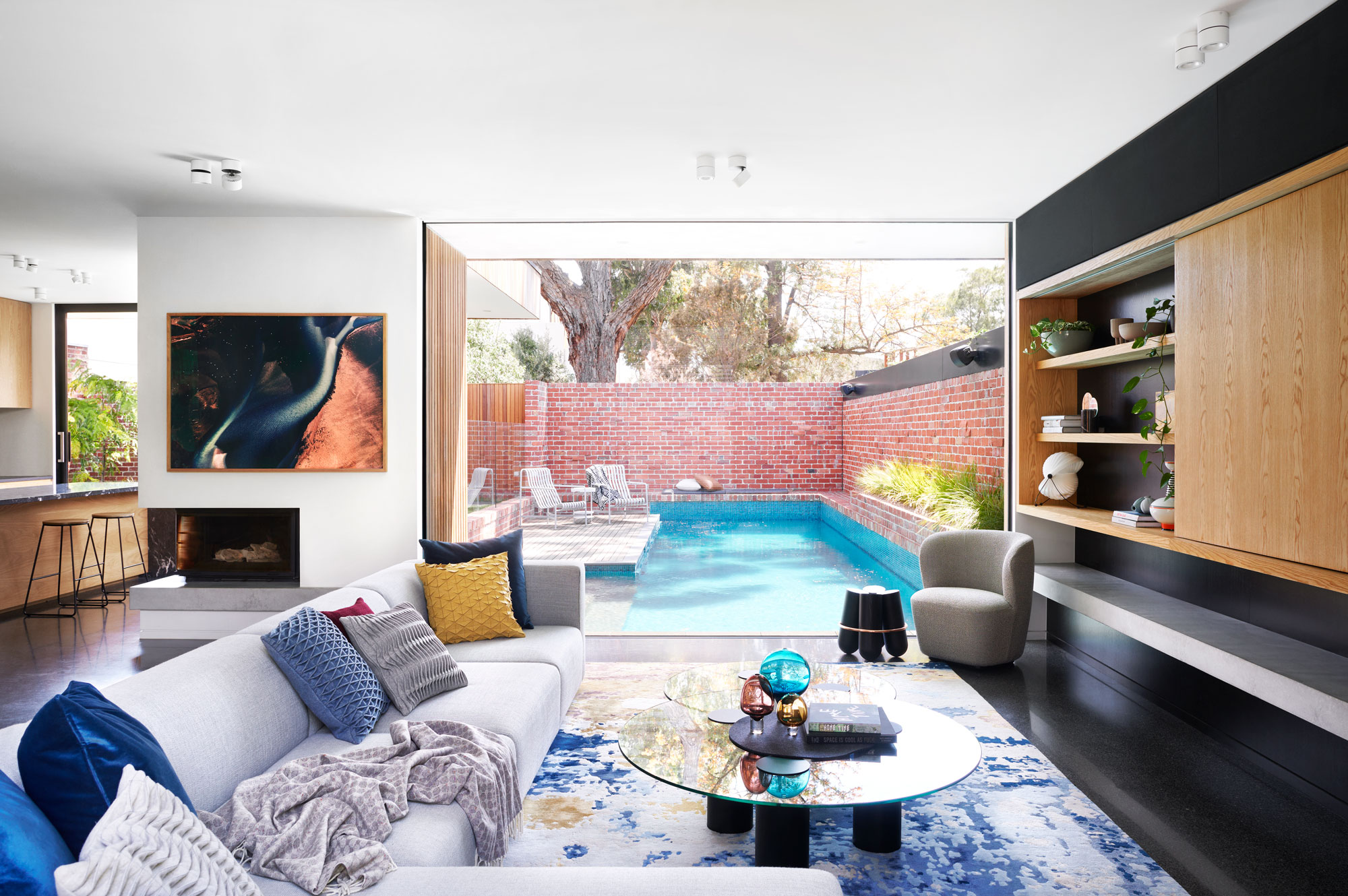
If you're working with a small garden footprint, the last thought in your mind might be including a swimming pool in your design. But for those who would love the option to be able to swim, there are ways to adapt your pool ideas for a small space.
Plunge pools can, for example, take up a similar space as a hot tub, and while not great for doing laps, are a great way to cool off in the summer heat.
Otherwise, you could consider designing a pool that stretches the width of an area of your backyard. While this may give you much less useable lounging or planting areas for your space, it all depends on what you want to use your garden for. For some, swimming may just win out.
5. Make use of every inch of outdoor space
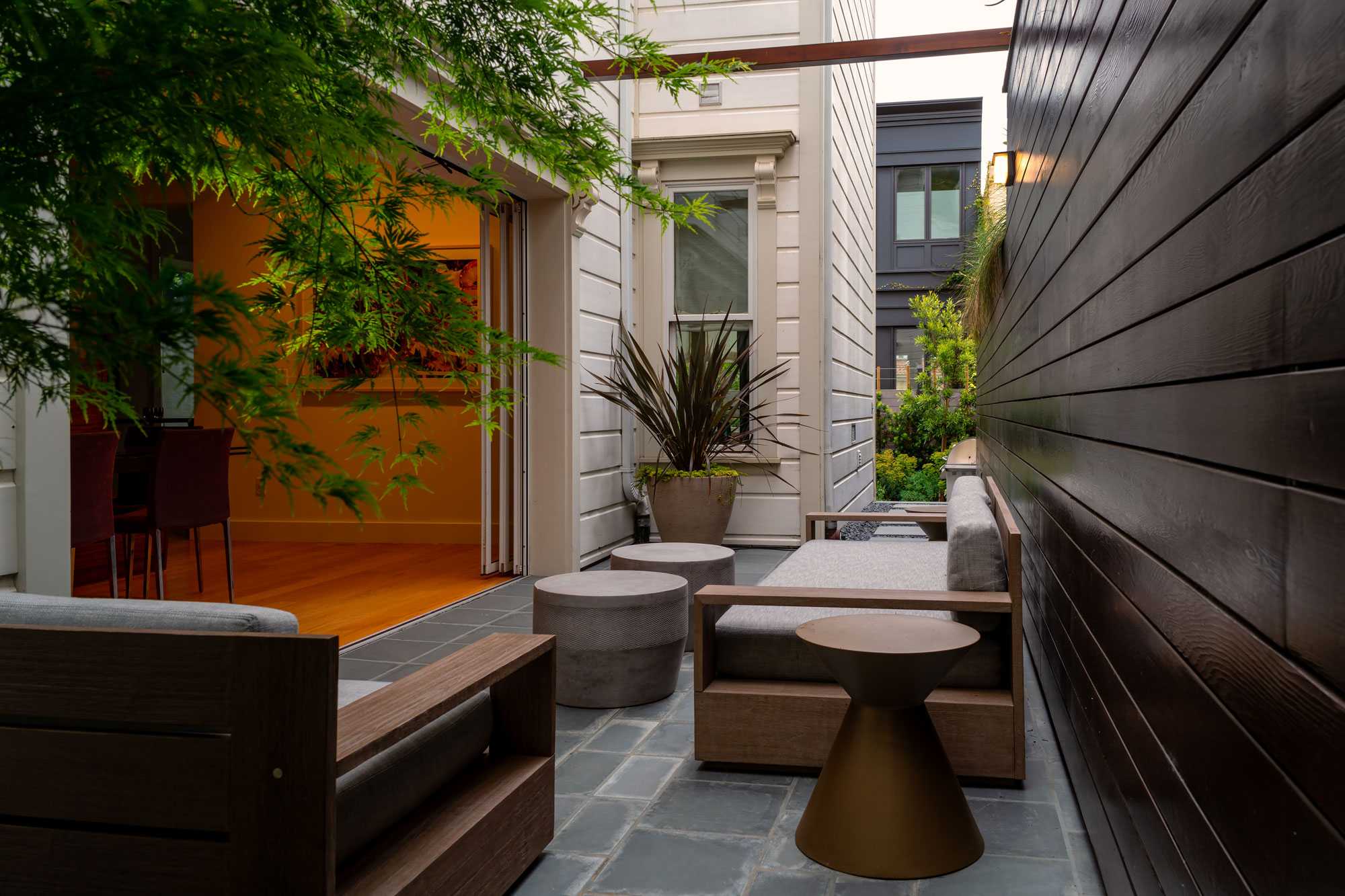
For some houses, outdoor space comes at a premium, so making the best use of it is important. Even a narrow passage at the side of a house could be used to extend your living space if used in the right way.
In this design, a small niche at the side of the house was transformed into a useable space by Steve Ritchey of Seed Studio Landscape Design. 'The main consideration here was how to make this narrow space inviting, since it is surrounded on three sides by high, multi-story vertical walls. My goal was to try and keep the viewer focused on the ground level, instead of looking up to the sky,' he explains.
Landscaping and planting was used to create more of a sense of a garden in this outdoor space, including one of the best trees for small gardens. 'A few cedar cross beams above the patio helped set a "ceiling" for the space, and placing a small Seriyu Maple tree helped reset the sense of vertical scale. We also relocated a few elements that typically would have been more conveniently placed by the kitchen sliding door such as an outdoor BBQ to the rear yard, to maintain more of a lounge vibe and keep the side space from getting too cluttered.'
6. Think big even in a small garden
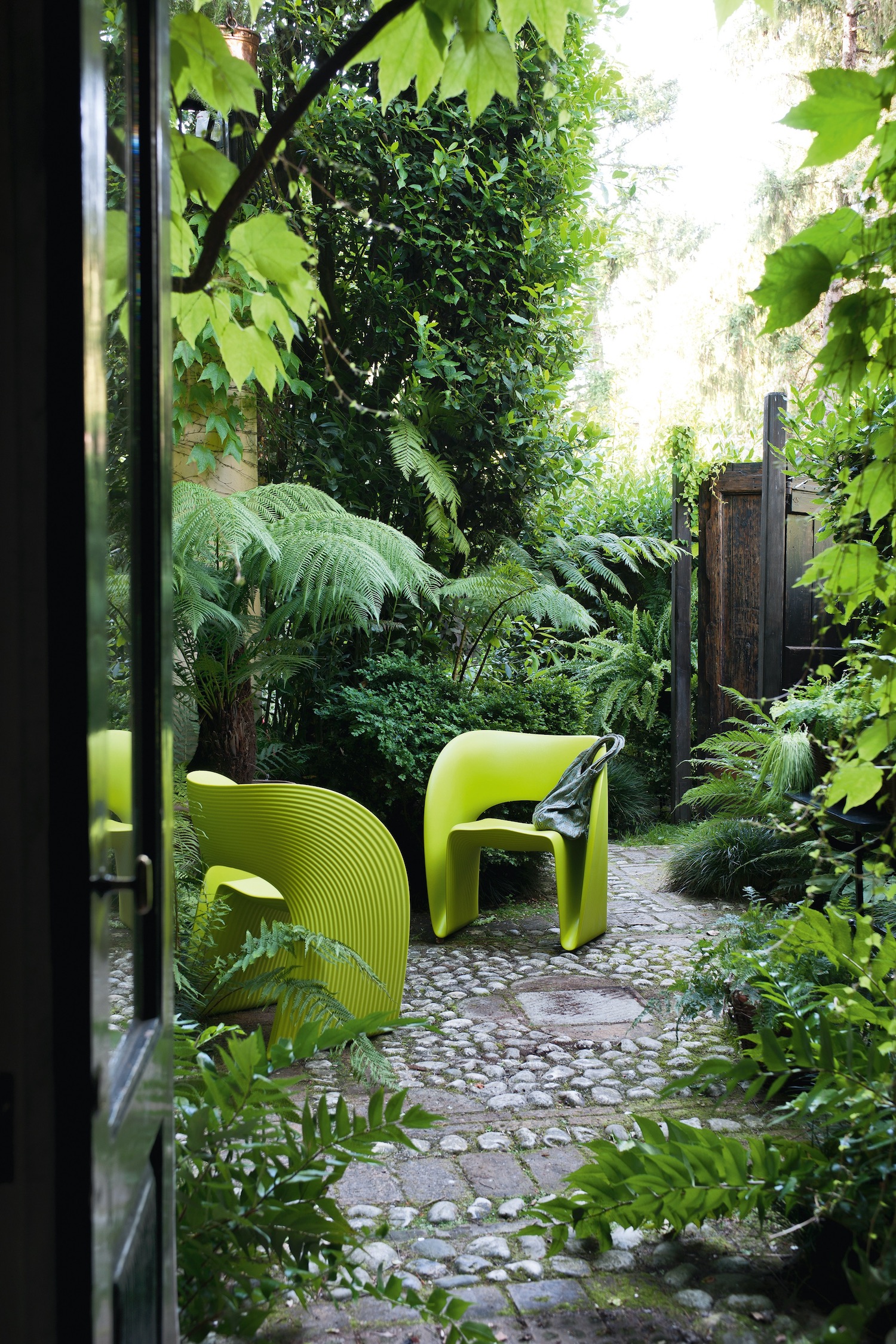
It is tempting in a small garden to keep everything small – small plants, small pots, small furniture but in fact keeping everything in scale with your small space will in fact only make it feel cluttered and smaller. Instead, opt for some large, stand-out plants that are going to add some drama and distract from the small dimensions.
'Whatever you do, don't fall into the trap of scaling everything down to fit. This won't make your garden look bigger and the result risks being twee. Think big and bold, be simple with your planting and dramatic with colors and forms: the space will expand before your very eyes!' continues Dan.
7. Create flower beds with containers

Container gardening is perfect for smaller spaces. No matter how small your garden/front yard/balcony/terrace/patch of pavement in front of your apartment, a container garden can add texture, color, vibrancy, and gorgeous scents too.
Pick pots that suit your style – try square concrete for a more modern feel, terracotta for all the Meditterean vibes or hunt on eBay for old pots if you like a more traditional English feel. Whatever look you go for, pick pots and plants in a variety of sizes and grow at different heights to create a display that rivals any flower meadow.
'If you don’t have beds but are relying on pots for growing plants, don’t have lots of small pots.' advises garden designer Angela Slater. 'Large pots with a single huge specimen plant strategically placed look much more effective. Just plant one variety in each pot and choose one with large imposing leaves, such as hostas, palms, cannas, bananas, or Fatsia.'
And when it comes to deciding on a flower bed color scheme for a smaller garden, Angela's advice is to 'Have a coherent color scheme, just stick to a couple of colors or even just green with just a few dashes of a color. Green and white gives a cool restful feel to the garden whereas hot reds, oranges, and yellow give it a tropical atmosphere.'
8. Layer your planting to give a small garden depth

As with smaller indoor rooms, when it comes to small garden ideas texture is key. It's texture that will add interest to your space can be used to blur the edges of your garden. Plants are the obvious way to bring in lots of different textures, so when choosing plants for a modern garden be sure to pick an array of sizes and shapes. But if you aren't particularly green fingers you can bring in texture with materials too – your choice of decking or patio paving, fences, trellises even furniture can all add to creating a small garden packed full of interest.
Angela suggests to 'Layer your plants to give depth. Start with tall narrow plants, such as bamboo, Italian Cypress (Cupressus sempervirens) or Irish Yew (Taxus baccata ‘Fastigiata’). The cypress and the yew also make ideal sentries either side of the door or beside a mirror at the end of the garden. Or plant a small tree with a high, light airy crown which will allow light to penetrate to the next level of plants.'
'Next comes the mid-layer; evergreen shrubs give you interest all year round and avoid having bare patches in winter, try Choisya ternate ‘Sundance’ (Mexican Orange) or Sarcocca humilis (Christmas Box) both of which have deliciously scented flowers. Finally, we come to the base layer, hostas, Brunnera, perennial geraniums and the evergreen Cornus canadensis would all cover a lot of ground and soften the edges of the path.'
9. Plan changes in level carefully in a small garden

Level changes in garden designs are often used to help zone different areas of a space, but in a small garden it can be a double-edged sword. Yes, a level change might give a bit more dimension to a compact backyard, but it also runs the risk of making a small space look even smaller with fussy detailing.
'I almost always let the site determine level changes, and seek to disturb the site as little as possible,' explains landscape designer Steve Ritchey. 'If the site slopes then I capitalize on that opportunity as best I can, and if the site is flat I typically don't try to introduce artificial grade changes.'
For this modern small patio idea, level changes follow the gradient of the garden, but while preserving as much level ground as possible to create this socializing spot around the firepit.
10. Ditch decking and opt for tiles in a small garden

Tiles used in place of decking or paving is a huge garden trend right now and it's a look that works perfectly in smaller gardens. Pattern, when used on the floor, can distract the eye from the dimensions of the space so pick a design that's going to play with perspective in your space.
If you are dealing with a narrow garden, draw the eye outwards with a horizontal design and vice versa for a more shallow garden, use your tiles to add length. And if something as bold as this doesn't match your vibe, pick a neutral tile or paving and use the layout for a similar space expanding effect. A long herringbone design is a go-to for smaller gardens.
11. Strategically place a mirror

A really simple small garden idea that's guaranteed to enhance a small graden is mirrors. It's design 101 that they make rooms feel lighter and loftier and the same goes for gardens. Depending on the look you are after, you could add a large simple mirror to the back wall of your garden to 'double' the space or opt for something more subtle and traditional with an antique mirror covered in climbers.
Angel suggests using a mirror to allude there is a second space beyond, 'Place a large full height mirror at the end of the garden and frame to look as if there is a doorway to another garden room. Frame the mirror with trellis planted with evergreen climbers or a wrought iron gateway.'
12. Consider your hardscaping materials too
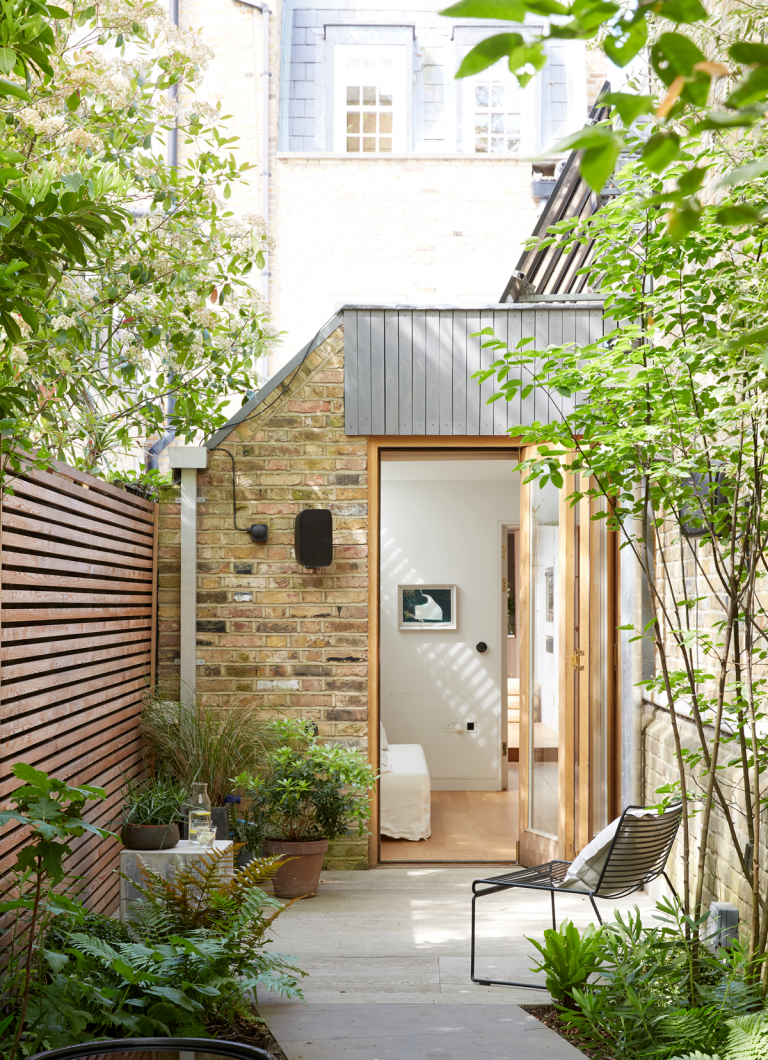
Again, the same rules that apply to many small rooms, apply to small gardens too – stick with lighter tones to help the space feel bigger and brighter. And we aren't just talking about your planting color schemes but your hard landscaping too. Decking, patios, paving etc. The colors and materials you choose can make all the difference.
'Use light-colored hard landscaping, for paths and patio areas.' suggest Angela. 'Granite and quartz both have a sparkly element which reflects the light. Add a couple of sculptural elements with large rocks at bends in the path where you can sit and pause for a few minutes. Paint any walls or timber structures in a light color too.'
13. Create zones within a small garden
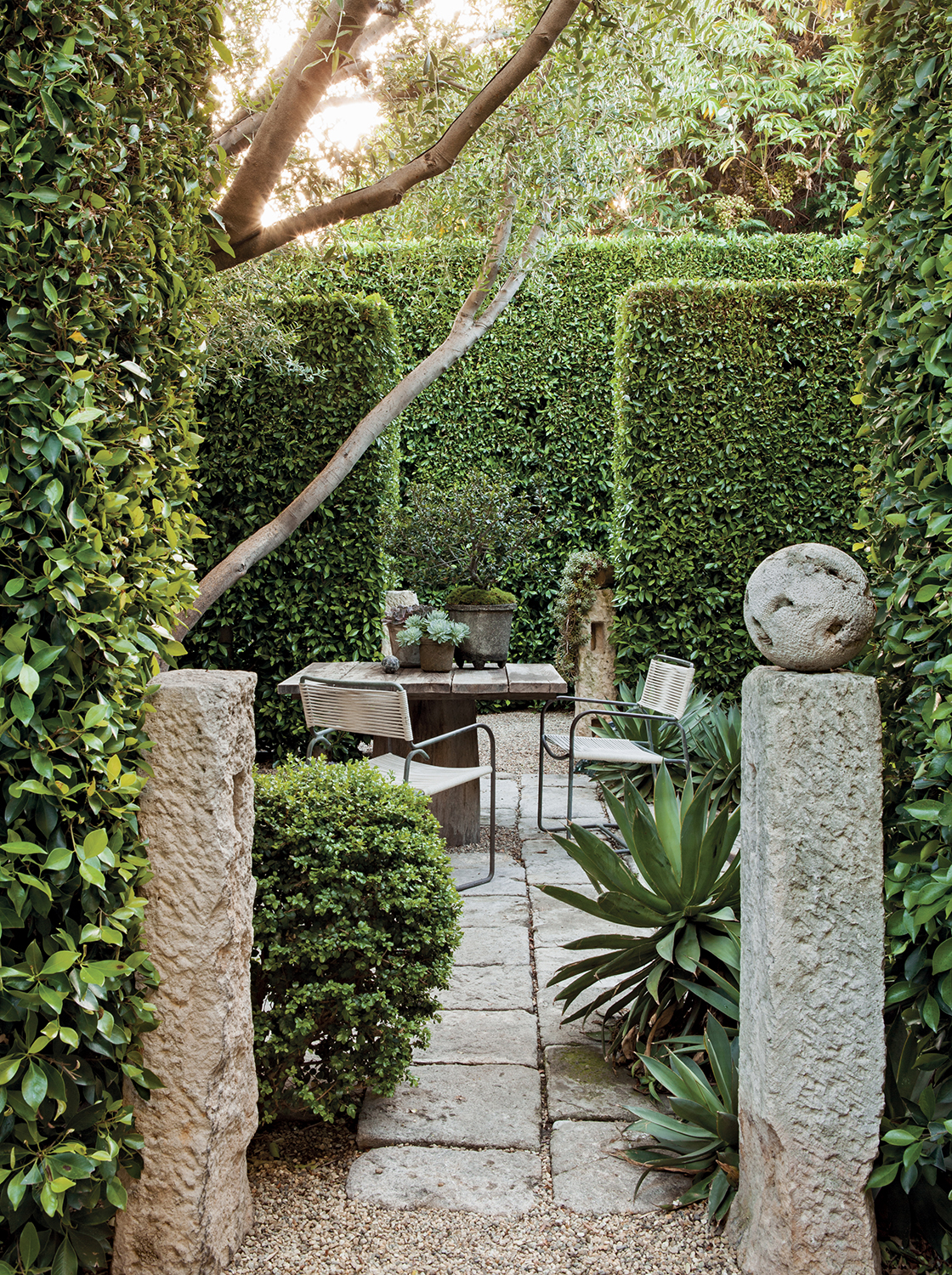
With a small garden it might seem odd to want to break it up into smaller sections, but by zoning your space into 'rooms' you and intrigue and this unknown of where the boundaries of the garden end can allude to more space.
'You can divide your garden using large plants, hedges, trellis or fences – it just depends on the look you are going for. And make sure to always leave plenty of room to walk around the different spaces, you want to create the feel of different zones, rather than section them off entirely.' explains Angela.
14. Create structure with (the right) trees

'Small gardens can benefit hugely from including a tree, wherever possible. Trees can add so much interest and structure to small spaces, where allowed.' says gardener Raine Clarke-Wills.
'People are often sceptical about planting a tree into their small garden, because they feel that it will make their garden feel smaller, when actually with careful planning, can have the opposite effect and create the feeling of space.'
'There are quite a few trees available for small gardens, some of them grown for their rich autumn leaf color, others for their scented blossom and some for their shape, structure or even for their bark.'
If you are keen to add trees to you small garden Raine suggests, 'Multi- stem osmanthus aquifolium, Amelanchier lamarckii, Cercis canadensis ‘Forest pansy', Acer griseum and Small Magnolias.'
15. Invest in good quality garden furniture that's multifunctional

Choosing the perfect garden furniture can be tricky in a small garden, but Angela's top piece of advice is to 'choose the best garden furniture you can afford such as treated hardwood or synthetic resin weave. It will not only last longer but can be left out all year round so you don’t need to include storage in your garden. If your space is truly tiny there are small folding sets available.'
'Unfortunately, will just have to accept that the large 8 seater set you’ve set your heart on is just impossible so consider smaller individual seats which can be used both in the house and garden, such as bean bags or cocoon chairs.'
Benches can be a good choice to as you can move them around the space as and when they are needed. Push them against a wall with a single bench if space is really tight and then when you have guests you can make it more of a feature in the center of the backyard.
16. Blend outside and in
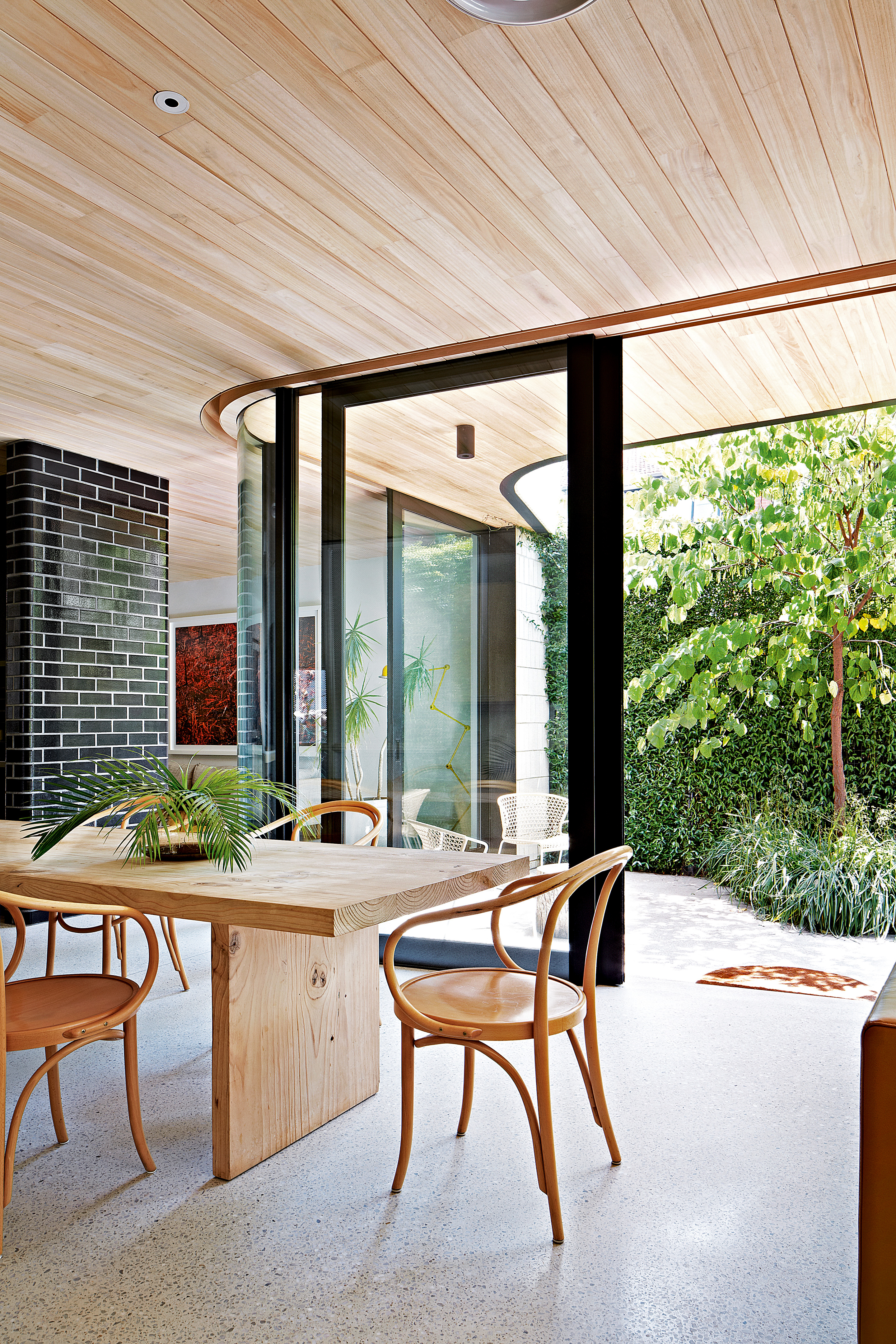
Indoor/outdoor living has been a massive garden trend for the past few years, with more and more homeowners wanting that seamless flow between inside and out. And the bodes well for small gardens! See it as borrowing space from in your home to creating the feeling of a bigger garden.
Having sliding or bi-folding doors between house and garden is an obvious way to link the two, however, your choice of flooring can have an equally blurring effect. Run the same or similar flooring from the room adjoining to your garden and your garden will instantly look larger and feel more like an extension of your home.
17. Create levels in a small garden

Adding levels is a great small garden idea as it not only makes the space more interesting but makes it feel bigger too as you create different zones within your garden. You could add a sunken garden or seating area or add a raised lawn or garden as you can see in this garden with steps leading up from a patio area.
Levels are great when your garden is a bit of an awkward shape too like this narrow, triangular design as it takes the eye level upwards, creating the allusions of a larger space. And don't be afraid to have a bit of fun with decor, it can act as a distraction from the tiny proportions. Angela suggests 'Place a few well-chosen accessories at strategic points, such as lanterns, small statues or interestingly shaped driftwood, in amongst the pots or in a corner.'
18. Make a small garden feel cozier with a fire

A lovely small garden idea that only going to enhance the coziness of the space (in a good way) is to add a fire. The obvious and easiest choice is to add a firepit and arrange comfy seating around it, but if floor space is really tight, copy this gorgeous firepit idea and have a fire installed into a boundary wall for a real outdoor living room feel.
19. Make use of vertical space
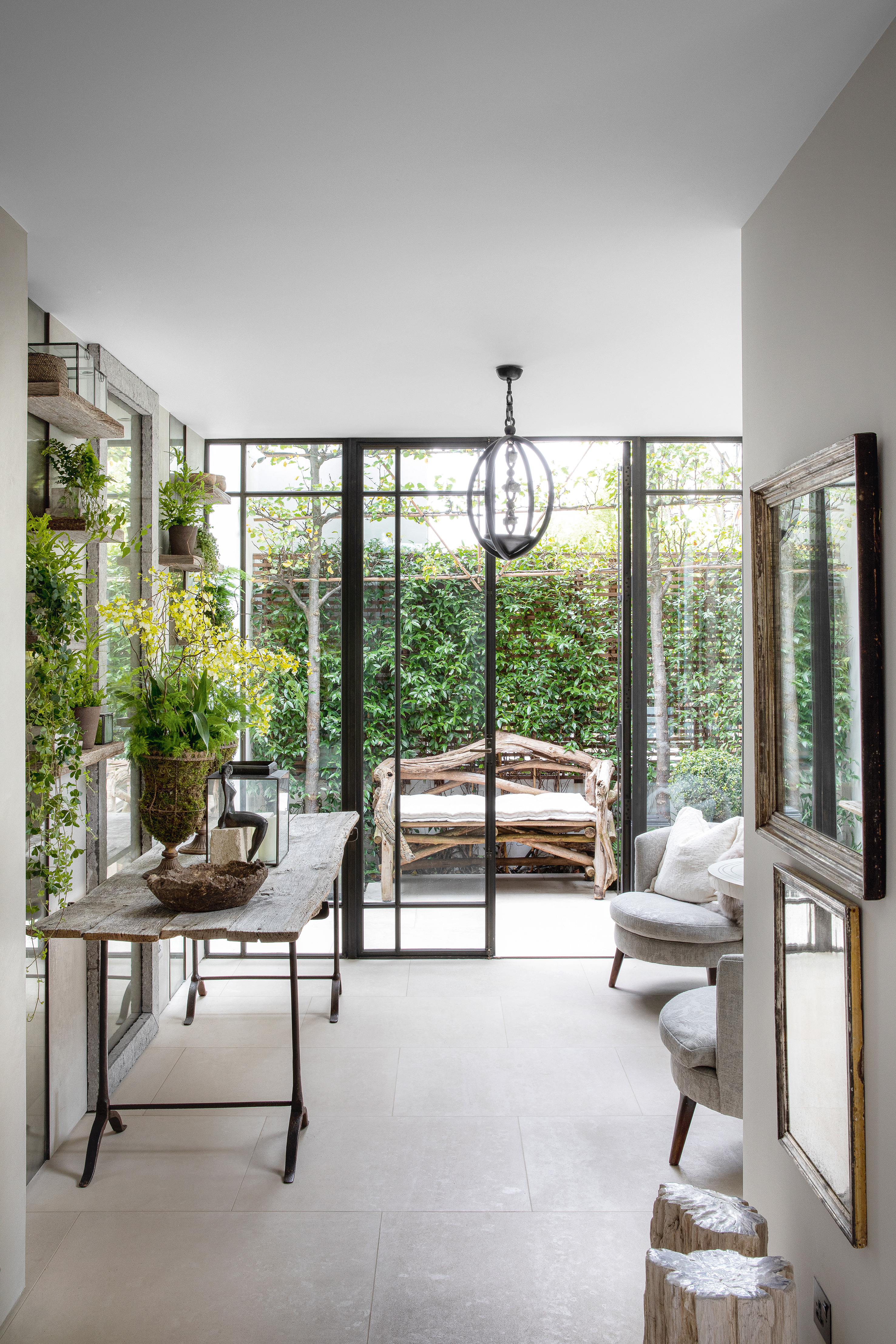
When floor space is lacking, look upwards for areas to add greenery. Plant trees that will grow upwards rather than outwards or fill the edges of your garden with climbers. You could even plant up a living wall and forgo borders to have more space at ground level to add a lawn or a patio.
20. Lengthen a small narrow garden with paths

Adding a garden path can trick the eye and make a garden appear longer. To further emphasize this, design a path that gets narrower as it leads to the end of the garden, and don't just stop it abruptly, fade it into a border so you can't clearly see where it ends.
Soften up the look of a paved path by allowing plants, such as mind-your-own-business to creep into the crevices. This looser approach to paving softens the look of a path, creates better drainage, and provides habitats for wildlife, too.
21. Build a seating area into a small garden

We've established that levels are good in a small garden, so take it to the next level and turn your small space into a sunken seating area with plants sitting above your patio.
This is a great modern outdoor furniture idea if you are not so big on gardening but often use your outside space for lounging or entertaining. Treat it like an outdoor living room with just a few lush (but low maintenance) evergreens and grasses to add texture and greenery.
How do you plan a small garden?
When planning a small garden the first thing to do is create a list of must-haves. Consider which elements are vital for you and your lifestyle and what you can forgo. For example, if you like you dine in your garden or often entertain then a patio area with seating would be essential, and you could skip having a lawn for that. And likewise, if you are more green-fingered and want to maximize on space for plants you might not have a patio at the top of your list.
What you don't want to do when planning a small garden is go overboard on your wishlist and end up with a large garden in miniature that has everything you want but feels cramped and functional. You might have to make some compromises, but less is definitely more when planning a small garden.
How do you layout a small garden?
The best layouts for small gardens are ones that zone the space or have different layers to it. Rather than just using the whole space as one dividing it up will add depth and interest and it can blur the boundaries of the garden too, making it appear larger.
How do you make a small garden look nice?
Making a small garden look nice is exactly the same as making a large garden look nice – fill it with texture and interest and decor that reflects the style of your home. Use mirrors to bounce light around and allude to more space. Layered planting will add depth and create the impression that the garden is more densely planted. Use garden lighting ideas too to create ambiance in your garden, hang fairy lights, add spotlights in the ground and dot candles around too for a magical effect.

Formerly the Digital Editor of Livingetc, Hebe is currently the Head of Interiors at sister site Homes & Gardens; she has a background in lifestyle and interior journalism and a passion for renovating small spaces. You'll usually find her attempting DIY, whether it's spray painting her whole kitchen, don't try that at home, or ever-changing the wallpaper in her entryway. She loves being able to help others make decisions when decorating their own homes. A couple of years ago she moved from renting to owning her first teeny tiny Edwardian flat in London with her whippet Willow (who yes she chose to match her interiors...) and is already on the lookout for her next project.
- Hugh MetcalfEditor